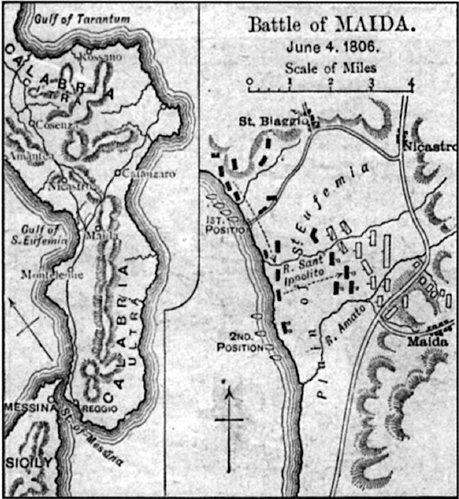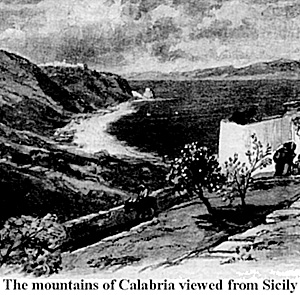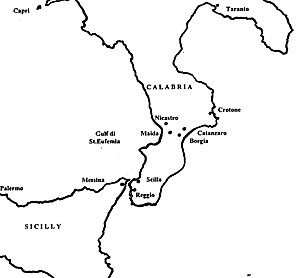Task Force To Calabria
Maida 1806
Introduction
by K F Bailey, UK
| |
Napoleon's attempts to strangle British trade through the Continental System and to harass the British trade routes to India in part drew France into the reoccupation of northern Italy and Naples. Britain's reaction was to create the Third Coalition allied to Prussia, Austria, and Russia. All was to be ruined by the capitulation of Mack's Austrian army at Ulm on the 15th October 1805 and the French victory on the battlefield of Austerlitz on the 2nd December 1805.
Prior to the break up of the Third Coalition, on the 21st November 1805 a joint force of 14,000 Russians under General Lacey from his base at Corfu and 8,000 British soldiers under Sir James Craig and Sir John Stuart from Malta landed near Naples. The Russians landed at Baia, the British at Castellammare accompanied by the Neapolitan Royal Family. The Intention was to disrupt the increasing French predominance in the Italian peninsular. Napoleon, on hearing of the allied landing, retaliated by deposing the King of the Two Sicilies to be replaced by Napoleon's brother Joseph.
The French Neapolitan Army of 25,000 occupied Abruzzo preparing to meet the allied advance. The Allies on hearing of he AustroRussian defeat of Austerlitz withdrew from the mainland of Italy. The British without the allied support withdrew but retained their foothold in the Italian peninsular by occupying Capri and Sicily. Massena and Joseph marched relentlessly through northern Italy to Naples, besieging Gaeta on route to the capital. The Council of Regency in Naples surrendered to Massena, General Reynier was dispatched into the Calabrian mountains to sweep away any further Neapolitan opposition to finally arrive at the straits of Messina in view of Sicily on the 25th February 1806.
In June 1806 King Ferdinand of the Two Sicilies, his Queen Maria-Carolina (sister to Marie-Antoinette) and Rear Admiral Sir Sidney Smith attempted to persuade General Stuart to raid the coastline of Calabria with the aim of disrupting French designs on Sicily. Smith in his orders from Admiral Collingwood was to harass French fortified positions along the Neapolitan coast, the regaining of Naples being considered as untenable. However, General Stuart suggested a more ambitious operation of invading Calabria with the view of maintaining a longer term advantage for the protection of Sicily.
Having embarked, General Stuart remained in occupation of the village of St. Euphemia pushing forward an advance detachment to Nicastro. He remained in position for 72 hours whilst horses, mules, provisions and ammunition were landed throughout the 2nd and 3rd of July. The landing was a slow and hazardous progress due to strong winds and the surf. It appears that Stuart was also delayed by waiting for an anticipated popular rising in support of the allied force but nothing materialised.
This pause enabled General of Division Jean Louis Ebenezer Reynier, the senior French Commander In Calabria (Marshall Massena was still engrossed in the siege of Gaeta, and General Gouvion St. Cyr was engaged in distant Apulia and Capitanata) to gather some 6440 men, including 328 cavalry and one battery of horse artillery This was organised into two brigades under Generals Compere and Digonet , the cavalry being commanded by Peyri . The force collected covered 80 miles in three days marching from Reggio to the approaches to san Pietro de Maida, camping on the high ground above the town on the evening of 3rd July.
Next morning both forces advanced to seek contact. Stuart passed parallel to the sea along the beach under the protection of the guns from the naval ship Apollo and 2 frigates, at each step of the way the force were shadowed by French cavalry on their left flank. At 7 am Sir John halted to view the French now settled in their strong position inland on a wooded hill. At 8 a.m. the British army wheeled left inland to meet their adversary pressing over a low lying area of bushes, marsh and scrub to the north of the River Lamato. Reynier waited until the enemy were out of range of the naval support and then sweeping down from his encampment on the ridge came on in four columns to cross the same rivulet further to the east pivoting on his left to face the British brigades having his cavalry and horse artillery on his open right flank.
The British Army advanced now in echelon of brigades with Kempt's Light Brigade furthest forward on the right wing. Next came Acland, and on the extreme left Cole. Oswald with the reserve was positioned a little behind and in the centre. At this stage the two fronts of the opposing forces were but three miles apart.
Map of Maida

More Task Force to Calabria Other Maida: Back to Table of Contents -- First Empire #54 Back to First Empire List of Issues Back to MagWeb Master Magazine List © Copyright 2000 by First Empire. This article appears in MagWeb (Magazine Web) on the Internet World Wide Web. Other military history articles and gaming articles are available at http://www.magweb.com |

 The task force was conveyed by Sir William Sidney Smith's naval squadron leaving Messina In Sicily on 27th June. After three days at sea the task force anchored off the Gulf of St. Euphemia. At dawn on the 1st July 1806, the first of 5200 officers and men embarked and landed virtually unopposed. The landing party met with a small force of 300 Poles, which were sent packing after the loss of two British Officers and fifty men. This initial landing provided the opportunity to land four field guns, two mortars and ten light mountain cannon.
The expeditionary force lacked cavalry to support accompanied by only 20 dragoons for exploratory use, the infantry advance guard and the three small brigades were commanded by Kempt, Acland, Cole and Oswald.
The task force was conveyed by Sir William Sidney Smith's naval squadron leaving Messina In Sicily on 27th June. After three days at sea the task force anchored off the Gulf of St. Euphemia. At dawn on the 1st July 1806, the first of 5200 officers and men embarked and landed virtually unopposed. The landing party met with a small force of 300 Poles, which were sent packing after the loss of two British Officers and fifty men. This initial landing provided the opportunity to land four field guns, two mortars and ten light mountain cannon.
The expeditionary force lacked cavalry to support accompanied by only 20 dragoons for exploratory use, the infantry advance guard and the three small brigades were commanded by Kempt, Acland, Cole and Oswald.